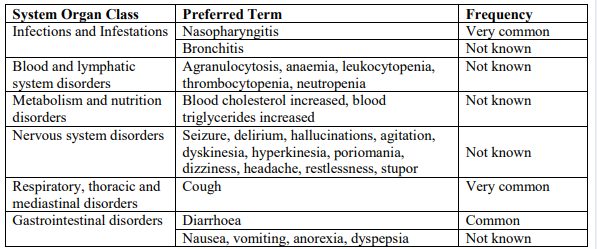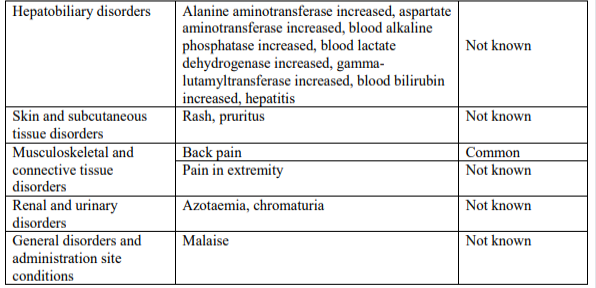| Identification | More | [Name]
Idebenone | [CAS]
58186-27-9 | [Synonyms]
2-(10-HYDROXY-DECYL)-5,6-DIMETHOXY-3-METHYL-[1,4]BENZOQUINONE
2-(10-hydroxydecyl)-5,6-dimethoxy-3-methyl-cyclohexa-2,5-diene-1,4-dione
cv 2619
IDEBENONE
4-dione,5,6-dimethoxy-2-(10-hydroxydecyl)-3-methyl-5-cyclohexadiene-1
6-(10-hydroxydecyl)-2,3-dimethoxy-5-methyl-1,4-benzoquinone
idebonone
Idebenone98.5%Min
2-(10-Hydroxydecyl)-5,6-methoxy-3-methyl-2,5-cyclohexadiene-1,4-dione
2,3-Dimethoxy-6-(10-hydroxydecyl)-5-methyl-1,4-benzoquinone
Avan
Daruma
Mnesis
IDEBENONE(PATENTED-NOSUPPLY)
5,6-Dimethoxy-2-(10-hydroxydecyl)-3-methyl-1,4-benzoquinone
5,6-dimethoxy-2-(10-hydroxydecyl)-3-methyl-5-cyclohexadiene-1,4-dione
cv 2619 idebenone
2-(10-Hydroxydecyl)-5�����,6-dimethoxy-3-methyl-2�����,5-cyclohexadienPl�����,4-dione
Daruma:Mnesis
2,5-Cyclohexadiene-1,4-dione, 5,6-dimethoxy-2-(10-hydroxydecyl)-3-methyl- | [EINECS(EC#)]
1308068-626-2 | [Molecular Formula]
C19H30O5 | [MDL Number]
MFCD00274552 | [Molecular Weight]
338.44 | [MOL File]
58186-27-9.mol |
| Chemical Properties | Back Directory | [Appearance]
Yellow-Orange Crystalline Solid | [Melting point ]
52-550C | [Boiling point ]
497.3±45.0 °C(Predicted) | [density ]
1.08±0.1 g/cm3(Predicted) | [storage temp. ]
Room temp | [solubility ]
Soluble in DMSO (up to 25 mg/ml). | [form ]
neat | [pka]
15.20±0.10(Predicted) | [color ]
Orange | [Usage]
Ubiquinone derivative with protective effects against cerebral ischemia. Nootropic | [Merck ]
14,4888 | [Stability:]
Stable for 1 year from date of purchase as supplied. Solutions in DMSO may be stored at -20°C for up to 3 months. | [InChI]
InChI=1S/C19H30O5/c1-14-15(12-10-8-6-4-5-7-9-11-13-20)17(22)19(24-3)18(23-2)16(14)21/h20H,4-13H2,1-3H3 | [InChIKey]
JGPMMRGNQUBGND-UHFFFAOYSA-N | [SMILES]
C1(=O)C(OC)=C(OC)C(=O)C(C)=C1CCCCCCCCCCO | [LogP]
3.490 (est) | [Uses]
idebenone(58186-27-9) is an anti-oxidant capable of protecting the skin from a variety of free-radical attacks, including the formation of secondary chemicals that negatively affect skin physiology. It is said to improve intrinsic as well as extrinsic skin damage caused by freeradical formation. Idebenone is a synthetically manufactured form of coenzyme Q10 and has a smaller molecular structure. This allows it to penetrate the skin and apparently the cellular membrane. Clinical studies demonstrate a visible improvement in photodamaged skin, reduced skin roughness and dryness, decreased fine lines and wrinkles, and increased skin hydration. In addition, idebenone helps improve hyperpigmentation because its molecular structure is similar to that of hydroquinone. Although most of the associated benefits are seen primarily in the epidermis, some increase in dermal collagen has also been confirmed. Idebenone has been used for such health-related problems as Alzheimer’s and heart disease.
| [CAS DataBase Reference]
58186-27-9(CAS DataBase Reference) |
| Hazard Information | Back Directory | [Description]
Idebenone(58186-27-9) is an organic compound belonging to the quinone family, being similar to coenzyme Q-10. It is a kind of drug developed by Takeda Pharmaceutical Company for the treatment of Alzheimer’s disease and some other cognitive defects. However, these have been not very much progress associated with this indication. It is now also used for the treatment of Friedreich’s ataxia with a positive effect on cardiac hypertrophy and neurological function. However, this indication is only approved in Canada, not in Europe and US. It is now under investigation on its efficacy for the treatment of Duchenne muscular dystrophy, Leber’s hereditary optic neuropathy, mitochondrial encephalomyopathy, lactic acidosis, and stroke-like episodes) as well as primary progressive multiple sclerosis. The efficacy of this drug still demands more evidences.
| [Chemical Properties]
Yellow-Orange Crystalline Solid | [Originator]
Takeda (Japan) | [Application]
Idebenone is ubiquinone derivative with protective effects against cerebral ischemia and cognition enhancer. It has been used:
chemotherapy drug
to treat mutant myocilin (mMYOC) cells for drug treatment assay
to validate C2C12 secondary cell screening assay
to treat obese mice, to test whether idebenone and CoQ10 bind directly to peroxisome proliferator-activated receptor (PPAR)LBDs, His-tagged PPARα, δ and γ LBDs | [Definition]
ChEBI: A member of the class of 1,4-benzoquinones which is substituted by methoxy groups at positions 2 and 3, by a methyl group at positions 5, and by a 10-hydroxydecyl group at positions 6. Initially developed for the treatment of Alzheimer's disease, benefits
ere modest; it was subsequently found to be of benefit for the symptomatic treatment of Friedreich's ataxia. | [Brand name]
AVAN | [General Description]
Idebenone is a short-chain benzoquinone drug. | [Biological Activity]
Antioxidant and neuroprotective agent. Protects mitochondrial membranes against lipid peroxidation and blocks glutamate neurotoxicity in vitro and in vivo . Inhibits apoptosis of astrocytes via increased NGF production. | [Biochem/physiol Actions]
Idebenone is used in the treatment of visual impairment in adolescents and adults with Leber′s hereditary optic neuropathy (LHON). It serves as an antioxidant. It helps to guard the heart muscle against oxidative stress.
| [Side effects]
The most common adverse reactions to Idebenone are mild to moderate diarrhoea (usually without the need to stop treatment), nasopharyngitis, cough and back pain.
The following adverse reactions emerging from clinical trials in LHON patients or reported postmarketing in other indications are tabulated below. Frequency groupings are defined to the following
convention: very common (≥1/10), common (≥1/100 to<1/10), not known (cannot be estimated from
the available data).

 | [Mode of action]
The mechanism of action of idebenone involves its antioxidant properties and ability to act as a mitochondrial electron carrier. Idebenone overcomes mitochondrial complex I respiratory chain deficiency in patients with LHON by transferring electrons directly to mitochondrial complex III (by-passing complex I), thereby restoring cellular energy (ATP) production and re-activating inactive-but-viable retinal ganglion cells, which ultimately prevents further vision loss and promotes vision recovery.
PID27071925 | [References]
1) Zs-Nagy (1990) Chemistry, toxicology, pharmacology and pharmacokinetics of idebenone: a review; Gerontol. Geriatr., 11, 177
2) Civenni et al. (1999) Inhibitory effect of the neuroprotetive agent idebenone on arachidonic acid metabolism in astrocytes; Eur. J. Pharmacol., 370 161
3) Takuma et al. (2000) CV-2619 protects cultured astrocytes against reperfusion injury via nerve growth factor production; Eur. J. Pharmacol., 406 333
4) Gerhardt et al. (2011) Idebenone and resveratrol extend lifespan and improve motor function of HtrA2 knockout mice; PloS One, 6 e28855 |
|
|